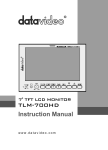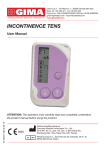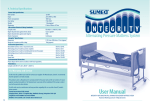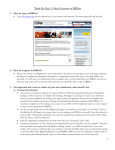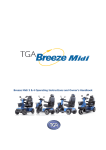Download A guide to using an electric wheelchair safely
Transcript
www.noc.nhs.uk/oce A guide to using an electric wheelchair safely Information for patients and their families OCE Oxford Centre for Enablement Neurological Rehabilitation Service page 1 page 2 Contents page Introduction 4 Using the Electric Wheelchair 6 Getting into your electric wheelchair 6 Safety Precautions 6 Driving the electric wheelchair 7 Testing checklist 8 Outdoor use of electric wheelchair, traffic law 9 Freewheel mode 11 Attendant Propelled 12 Important safety tips 13 Chair limitations 14 Battery charging and care of battery 15 Lap belt, maintenance 17 Returning your electric wheelchair 18 page 3 Introduction As part of your care at the Nuffield Orthopaedic Centre you have been loaned an electric wheelchair to assist your mobility at the OCE. This booklet describes how you can use the wheelchair safely indoors and around the hospital site. It is important that you read this booklet and follow the safety instructions with care. Misuse of your electric wheelchair can lead to accidents and injuries. Your Occupational Therapist (OT) will have carried out an assessment to recommend the most suitable electric wheelchair for you. The OT will assess your ability to use it safely and look after it during the loan period. You will have to demonstrate your ability to operate the electric wheelchair safely and independently before it is loaned. If you are unsure about any elements of using the supplied electric wheelchair, experience difficulties or detect a fault requiring repair, please contact your named OT. You will also have access to a manual wheelchair which you should use until the fault has been repaired. Please note this is a general guide for all models of electric wheelchairs, please refer to the specific user manual for more detailed information. page 4 Electric Wheelchair back rest controls arm rest footplates page 5 Using the Electric Wheelchair Getting into your Wheelchair • The power must be turned off. • The footplates should be removed or swung out of the way. •Transfer to the electric wheelchair using your recommended transfer method. •The footplates can now be repositioned down and place your feet comfortably. • Fasten lap belt. Getting out of your Electric Wheelchair •The power must be off. • The footplates should be removed or swung out of the way. • Unfasten lap belt. • Transfer using your recommended. transfer method. •Make sure the electric wheelchair is put on charge (if being left over night). Ensure it is stored out of the way so no-one can trip over it. page 6 Driving the electric wheelchair •Always make sure to use a lap belt when operating your electric wheelchair. •The basics of driving your electric wheelchair is to point the joystick controller in the direction of travel. •When you are driving the electric wheelchair always make sure that both feet are on the footplate to ensure that they do not get trapped under the wheels. •There is a button to adjust the speed of your wheelchair. Your OT will advise a safe speed for you. page 7 Testing Checklist The table shows the skills required to demonstrate safe use of operating an electric wheelchair. Skills demonstrated Turn controls on & off Regulate Speed of chair Directional control Negotiating narrow openings Reversing Coping with cambers & slopes 180 degree turn on slope Manoeuvring in confined spaces Coping with different surfaces Awareness of obstacles Awareness of others Ascending slope Descending a slope Mounting a kerb Descending a kerb safely Emergency stop Road crossing, demonstrating safety awareness page 8 Yes/No Comments Outdoor use of electric wheelchair should only occur when supervised by an OT •Take care when using your electric wheelchair on slopes of a 10% to 20% gradient and avoid them if possible. Only use them when the surface is firm, straight and dry. •Avoid uneven surfaces •Avoid going out in wet or icy weather conditions. •Do not attempt to drive across slopes, which can cause the electric wheelchair to become unstable. •Start slowly and accelerate cautiously when climbing slopes. •When travelling down slopes select a low speed and stop if the electric wheelchair starts to go too fast. Do not lean forward in the chair when going down slopes. •Always make sure that your electric wheelchair is fully charged before taking your chair on a journey and check the maximum range your chair can go before running out of battery. •Plan your route to avoid negotiating kerbs and instead look for dropped kerbs when crossing the road. •Use of the electric wheelchair will be assessed by a named OT and will only be used locally to the hospital and is not to be used outside of the hospital for weekend, day or evening leave page 9 Traffic Law Adapted from Department of Transport: The use of Invalid Carriages on Highways Regulations 1988 No 2268. A number of laws form the basis upon which wheelchairs are supplied as they define the type of invalid carriage that can be used on our footpaths and the circumstances in which they can be used on the road. Throughout this document the term “wheelchair” is used for convenience but be aware that the regulations apply to all invalid carriages which are “vehicles, whether mechanically propelled or not, for the use of one person suffering from some physical defect or disability”. Wheelchairs are divided into three classes: Class 1 Not Mechanically propelled. Class 2 Mechanically propelled, but incapable of more than 4mph. Class 3 Mechanically propelled, but incapable of more than 8mph. The following rules apply: •Powered wheelchairs (Class 2 and 3) must not be driven at more than 4mph on the footway. •Class 2 wheelchairs must have front and back lights and reflectors if they are used on roads between sunset and sunrise except for the purpose of crossing it. All class 3 wheelchairs must have lights and reflectors at all times. •You need to be aware that only Class 3 vehicles are intended for use on the public highway. page 10 Freewheel mode If the chair is to be pushed manually. The electric wheelchair is fitted with two levers to disengage the motor. When the motor has been disengaged the electric wheelchair can then be pushed. However the electric wheelchair is heavy and it is advised that it is not pushed over long distances. The following instructions should be followed carefully: To disengage the drive, turn both levers to point OUTWARDS. To reengage the drive turn both levers PARALLEL TO THE WHEELS Push the chair slightly forwards to ensure that both motors are fully locked in the drive position. When the electric wheelchair is in the disengaged mode the wheel brakes need to be applied manually. When the electric wheelchair is In the engaged mode always ensure power is off before transferring into or out of the chair. The electric wheelchair should always be in the engaged mode when it is occupied unless there is an attendant available to push the electric wheelchair. page 11 Attendant Pushing Always make sure the brakes are on when the electric wheelchair is not being pushed. Make sure both feet are on the footplates. Ensure elbows, all clothing, rugs or bags are tucked in. Look well ahead for possible hazards. Avoid steep, soft or uneven surfaces as these will make it harder to push or could cause the electric wheelchair to tip over. Always let the person in the electric wheelchair know what you are going to do e.g. turning quickly. Do not hang heavy bags or shopping on the handles of the electric wheelchair. This can change the centre of gravity and cause the electric wheelchair to tip backwards. page 12 Important Safety Tips It is important that you take note of these safety tips to ensure your safety whilst using the electric wheelchair. Reaching and Bending Forwards • Avoid leaning forwards (beyond the armrests). • Avoid bending to reach low objects. • Avoid reaching behind you over the top of the back rest. Electric wheelchairs can be quiet, make sure others are aware of you. Brakes Always make sure that the brakes are applied when you are stationary. The brakes come on automatically when the electric wheelchair is turned off. Footrests Never stand on footrests. This could cause the wheelchair to tip forwards. page 13 Chair Limitations The battery will only enable the electric wheelchair to go a limited distance. All the electric wheelchairs vary slightly. A guideline for a regular trip would be approximately 7 miles. If travelling a longer distance or over hills and/or rough ground, the battery capacity of the electric wheelchair will be reduced. It will also be reduced in very cold weather of if additional weight is added to the electric wheelchair. The electric wheelchair is not designed to carry bags on the push handles and carrying bags in this way will alter the stability of the electric wheelchair and is not recommended. Do not drive the electric wheelchair beyond its capabilities e.g. muddy areas or loose gravel. Be aware that loss of wheel grip can be hazardous e.g. on grassy or otherwise slippery slopes. Do not use the electric wheelchair if the controller, brakes or any other crucial components are known to require repair. page 14 Charging the battery Only use the charger that has been supplied to you by your OT. The charger will have a code which will match the code on your electric wheelchair. THIS IS VERY IMPORTANT. Always follow the charging instructions as stated on the front panel of the charger. This will be demonstrated by your OT. Stand the charger on a level surface ensuring an adequate flow of air around it all times. Never cover the charger and keep it away from water and damp conditions. Charge until the light indicates it is fully charged or leave overnight. Switch off at the mains before disconnecting the charger from the electric wheelchair when the battery is fully charged. Do not switch the charger on until you have plugged it into the electric wheelchair-charging socket. Do not use the charger outdoors Do not sit in your electric wheelchair while it is charging. IF YOU HAVE ANY PROBLEMS CHARGING YOUR ELECTRIC WHEELCHAIR PLEASE CONTACT YOUR OT page 15 Looking after your battery and charger The following information has been written to optimise the performance of the battery and charger. DO NOT attempt to remove the valve covers. DO NOT put any metal objects on top of the battery. This is dangerous and can damage the battery and create sparks. Always keep the battery charged. The light indicators on the controller will indicate the level of charge within the battery. Leave the battery in a fully charged state before any long period of non-use of the electric wheelchair. The charge will hold for months. The acid within gel batteries is fixed within the gel itself. It can only escape if the casing is damaged. It is still acid and will burn. Avoid contact with skin and eyes. If the acid comes into contact with your skin or eyes, wash if off with water and consult your doctor immediately. page 16 Lap Belt Always securely fasten the lap strap or any safety harness if this has been supplied by your OT. Observe weight limits. Do not carry other adults/children/luggage in or on the electric wheelchair. Maintenance Before you were loaned your electric wheelchair it will have been checked and received regular servicing. Please let your OT know if you have any maintenance issues. Check the electric wheelchair regularly for any defects or damage. This is essential for your safety and most effective use. 1.Brakes Check they are secure, properly adjusted and operate correctly. 2.Wheels/Tyres Check tyres are inflated and check tyre tread. 3.Upholstery/Frame Check there are no tears to the back and seat canvases. The canvas and frame can be cleaned with warm soapy water. 4.Fixings Check nuts/bolts for the footplates, armrests and any accessories you have been loaned. If you are in any doubt about the safety of the electric wheelchair, or suspect a fault please contact your Occupational Therapy Department (listed on the last page of this booklet). Do not attempt to repair the electric wheelchair yourself or modify any parts of the chair. This may render it unsafe to use. page 17 Returning your Electric Wheelchair Your electric wheelchair has been provided on temporary loan from the Occupational Therapy Department at the Nuffield Orthopaedic Centre. The Occupational Therapy Service is dependent on the safe and timely return of the wheelchair in order to provide a service to other patients. You will be given a Loans Receipt with the loan details and who to contact to arrange the return of the wheelchair. Many of our wheelchairs have been generously funded by local charities and the hospital League of Friends. Please make sure you bring your wheelchair back clean and serviceable for the benefit of others. Loan electric wheelchairs are only for use at the OCE and must be returned to OT prior to discharge page 18 Produced by: Corinna Green, Occupational Therapist Hayley Brown, Occupational Therapist Jo Glossop, Occupational Therapist Will Downey, Occupational Therapy Assistant page 19 Are we speaking your language? A Guide to using your wheelchair safely Reviewed: 25th May 2011 by NRS and CDMS Occupational Therapists © 2011 Nuffield Orthopaedic Centre OMI ref: 3530 If you would like information in another language or format, please call 01865 738126
























